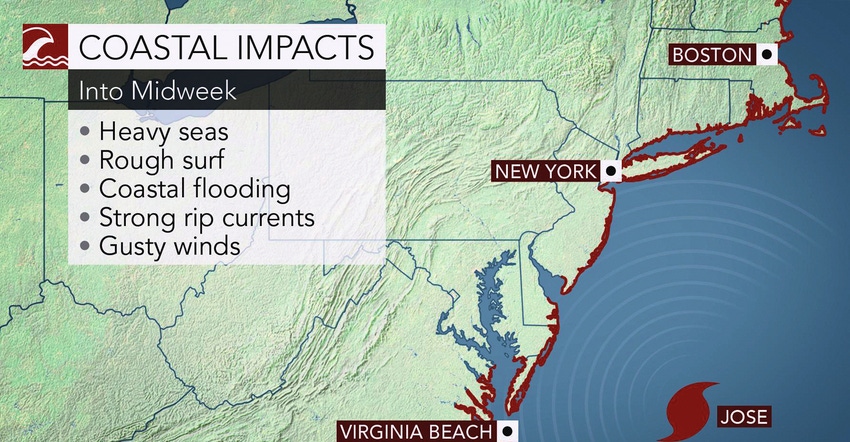
Even if Hurricane Jose doesn’t invade the Northeast’s inlands, it’s likely to pump cloud cover and rainfall into the region and further delay fall harvests. That’s the bottom line of the latest reports from AccuWeather and Cornell University’s ProDairy. And, more may be in store.
As of Friday, Jose was expected to pass within 200 miles of the Northeast coast. But a New England landfall can’t be ruled out, according to AccuWeather Senior Meteorologist Dan Pydynowski. The exact track and strength of Jose will determine severity of the wind and extent of rainfall.
A hurricane doesn’t need to make landfall to cause significant adverse Northeast effects, he adds. The shape of the coast tends to enhance storm effects and trap ocean water. Gusts to 50 mph are possible from eastern Maryland to Maine and are likely on Cape Cod, Mass.
Should Jose be stronger than a Category 1 hurricane and/or make landfall, more significant effects are likely. A landfall in southeastern New England could cause heavy rain and gusty wind to spread well inland across the Northeast.
Corn maturity already slowed
As if Northeast corn growers didn’t have enough, growing degree day accumulation continued to be below average in August and early September in New York state and points northward. That has slowed corn crop maturation, according to the recent Cornell ProDairy Harvest Outlook report.
Updated 2017 GDD data shows that over the last 50 days, New York is 130 to 190 GDDs behind the average. Given low daily GDD accumulation in late October and early November, and average accumulation in September and October, it’ll take approximately three to four weeks to make up the deficiency. This means that corn silking around Aug. 10 would have a projected harvest date around the second week of November.
Here are three keys for success from Pro-Dairy’s Managing Forage Quality: A Challenging Growing Season webinar:
• Separate fields by those likely to fully mature for silage and those likely to be harvested at an immature stage.
• Identify separate storage areas to store mature (dairy-quality silage) and immature (non-lactating-quality silage).
• When identifying temporary storage sites, consider site drainage, runoff risk and concentrated animal feeding operation guidelines.
About the Author(s)
You May Also Like




